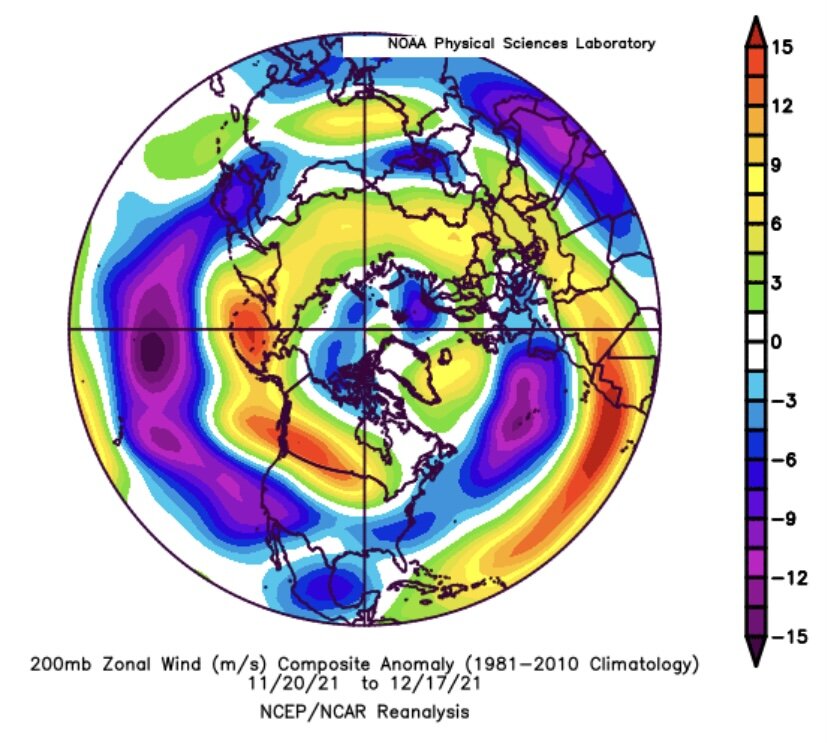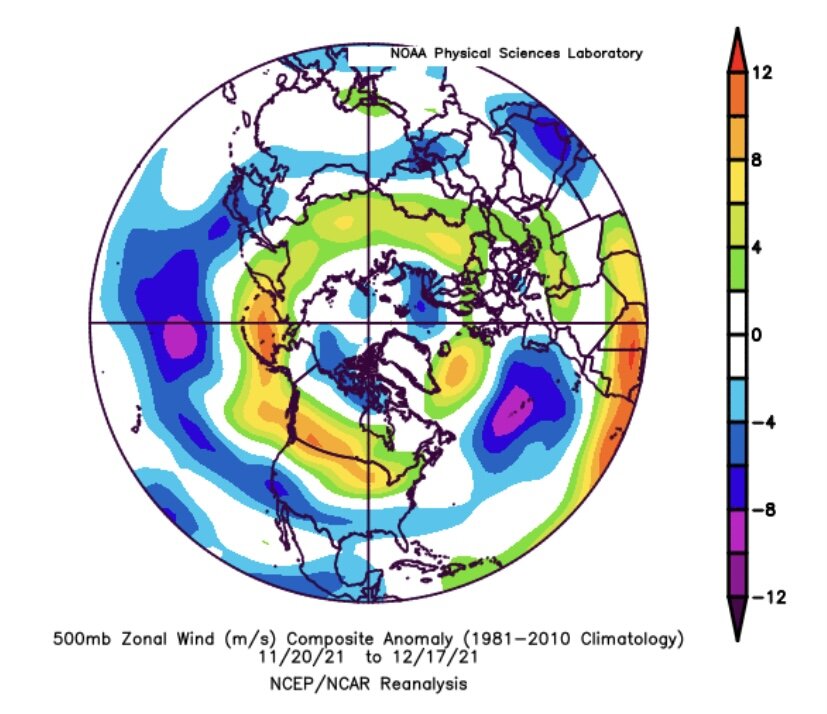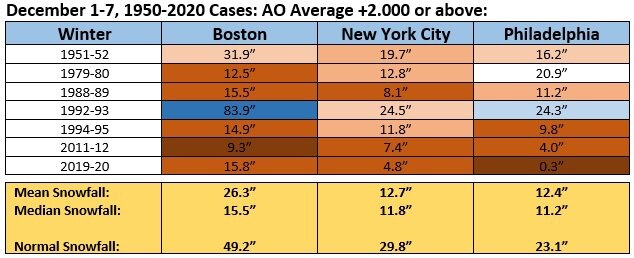-
Posts
23,241 -
Joined
Content Type
Profiles
Blogs
Forums
American Weather
Media Demo
Store
Gallery
Everything posted by donsutherland1
-
Morning thoughts… It will be mostly cloudy today. It will turn milder. High temperatures will likely reach mainly the middle and upper 40s in most of the region. Likely high temperatures around the region include: New York City (Central Park): 44° Newark: 48° Philadelphia: 52° Normals: New York City: 30-Year: 42.1°; 15-Year: 43.0° Newark: 30-Year: 42.6°; 15-Year: 43.7° Philadelphia: 30-Year: 43.9°; 15-Year: 44.9° The remainder of December will see generally above normal temperatures.
-
I wish everyone a quick recovery.
-
Overnight, a system could bring a coating of snow north and west of Philadelphia, Newark and New York City. There is a small chance that one of these cities could pick up a measurable amount. It will then turn milder tomorrow. Afterward, a generally mild remainder of December lies ahead. It will be a different story in the Pacific Northwest. Near record to record cold, along with snowfall, is possible during the closing days of December in such cities as Portland, Seattle, and Vancouver. January will likely commence with an AO-/PNA- pattern. That typically favors somewhat cooler than normal readings in the East. For NYC, the January 1-10, 1991-2020 mean temperature for such cases was 33.5° (normal: 34.8°). The latest guidance suggests that temperatures could head toward seasonal levels and then periodically below seasonal levels as the first week of January progresses. The coldest air will likely remain confined to the Pacific Northwest, Northern Plains, and western and central Canada. No severe cold is likely through at least the first week of January. There are some hints that a milder pattern could begin to develop around mid-January. In the Midwest, through 4 pm CST today, Chicago has yet to receive its first measurable snowfall. The old record latest first measurable snowfall was December 20, 2012. Following very wet July-September periods, winter (December-February) precipitation has typically been near or below normal. The most recent exception was winter 2018-19. The ENSO Region 1+2 anomaly was -1.7°C and the Region 3.4 anomaly was -1.1°C for the week centered around December 15. For the past six weeks, the ENSO Region 1+2 anomaly has averaged -1.15°C and the ENSO Region 3.4 anomaly has averaged -0.93°C. La Niña conditions will likely persist through meteorological winter. The SOI was +8.46 today. The preliminary Arctic Oscillation (AO) figure was -1.419 today. On December 21 the MJO was in Phase 7 at an amplitude of 2.341 (RMM). The December 20-adjusted amplitude was 2.099 (RMM). Based on sensitivity analysis applied to the latest guidance, there is an implied near 100% probability that New York City will have a warmer than normal December (1991-2020 normal). December will likely finish with a mean temperature near 43.1° (4.0° above normal). That would tie 2021 with 1998 as the 6th warmest December on record.
-
There is some possibility. Some of the underlying drivers e.g., strong PDO- have remained relatively intact. The wave lengths have shortened. A La Niña has developed. A La Niña combined with a PNA- has often seen significant cold and snowy outcomes in the Pacific Northwest.
-
Morning thoughts… It will be partly sunny and cool today. High temperatures will likely reach mainly the middle and upper 30s and lower 40s in most of the region. Likely high temperatures around the region include: New York City (Central Park): 37° Newark: 40° Philadelphia: 40° Normals: New York City: 30-Year: 42.3°; 15-Year: 43.2° Newark: 30-Year: 42.8°; 15-Year: 43.9° Philadelphia: 30-Year: 44.1°; 15-Year: 45.1° Overnight, a weak system could bring a coating of snow to the north and west of Philadelphia, Newark, and New York City. There is a small chance that each of these cities could also pick up a measurable snowfall. Milder air will return afterward.
-
Another push of modestly colder air will bring down temperatures tomorrow, but a generally mild remainder of December lies ahead. It will be a different story in the Pacific Northwest. Near record to record cold, along with snowfall, is possible during the closing days of December in such cities as Portland, Seattle, and Vancouver. January will likely commence with an AO-/PNA- pattern. That typically favors somewhat cooler than normal readings in the East. For NYC, the January 1-10, 1991-2020 mean temperature for such cases was 33.5° (normal: 34.8°). The latest guidance suggests that temperatures could head toward seasonal levels and then below seasonal levels as the first week of January progresses. The coldest air will likely remain confined to the Pacific Northwest, Northern Plains, and western and central Canada. No severe cold is likely through at least the first week of January. There are some hints that a milder pattern could begin to develop around mid-January. In the Midwest, through 4 pm today, Chicago has yet to receive its first measurable snowfall. The old record latest first measurable snowfall was December 20, 2012. Following very wet July-September periods, winter (December-February) precipitation has typically been near or below normal. The most recent exception was winter 2018-19. The ENSO Region 1+2 anomaly was -1.7°C and the Region 3.4 anomaly was -1.1°C for the week centered around December 15. For the past six weeks, the ENSO Region 1+2 anomaly has averaged -1.15°C and the ENSO Region 3.4 anomaly has averaged -0.93°C. La Niña conditions will likely persist through meteorological winter. The SOI was -12.87 today. The preliminary Arctic Oscillation (AO) figure was -1.704 today. On December 20 the MJO was in Phase 7 at an amplitude of 2.096 (RMM). The December 19-adjusted amplitude was 1.615 (RMM). Based on sensitivity analysis applied to the latest guidance, there is an implied 99% probability that New York City will have a warmer than normal December (1991-2020 normal). December will likely finish with a mean temperature near 42.9° (3.8° above normal).
-
Morning thoughts… Light rain will give way to sunshine. It will become windy. High temperatures will likely reach mainly the middle and upper 40s in most of the region. Likely high temperatures around the region include: New York City (Central Park): 46° Newark: 50° Philadelphia: 48° Normals: New York City: 30-Year: 42.5°; 15-Year: 43.4° Newark: 30-Year: 43.0°; 15-Year: 44.1° Philadelphia: 30-Year: 44.3°; 15-Year: 45.3° Tomorrow will be sunny but cold. Milder air will return afterward.
-
It’s looking less promising, but some cold could still sink southward into the region. Severe cold isn’t likely. Tomorrow’s EPS weeklies will provide further insight.
-
Seattle had its wettest fall (19.04”) on record. Climate change is a function of forcings, not internal variability. The persistent NAO- would not change the ongoing energy imbalance that is resulting from an enhanced greenhouse effect.
-
Temperatures rose into the 40s today. Tomorrow will be another mild day before a brief push of modestly colder air knocks down temperatures on Thursday. Overall, temperatures will generally be near or above normal throughout much of the remainder of December. No severe cold is likely through the remainder of December. It will be a different story in the Pacific Northwest. Near record to record cold, along with snowfall, is possible during the closing days of December in such cities as Portland, Seattle, and Vancouver. Afterward, if the small sample of cases where the MJO moved into Phase 7 at a high amplitude (1.75 or above) during the December 10-20 period, as occurred this month, is representative, the first 10 days of January could see below to perhaps much below normal temperatures. However, the coldest air will likely remain confined to the Pacific Northwest, Northern Plains, and western and central Canada for much of this period. January will likely commence with an AO-/PNA- pattern. That typically favors somewhat cooler than normal readings in the East. For NYC, the January 1-10, 1991-2020 mean temperature for such cases was 33.5° (normal: 34.8°). There are some hints that a milder pattern could begin to develop around mid-January. In the Midwest, through 4 pm today, Chicago has yet to receive its first measurable snowfall. The old record latest first measurable snowfall was December 20, 2012. Following very wet July-September periods, winter (December-February) precipitation has typically been near or below normal. The most recent exception was winter 2018-19. The ENSO Region 1+2 anomaly was -1.4°C and the Region 3.4 anomaly was -1.1°C for the week centered around December 8. For the past six weeks, the ENSO Region 1+2 anomaly has averaged -1.00°C and the ENSO Region 3.4 anomaly has averaged -0.92°C. La Niña conditions will likely persist into at least late winter. The SOI was -27.14 today. That is the lowest value since June 20, 2020 when the SOI was -33.95. The preliminary Arctic Oscillation (AO) figure was -1.453 today. On December 19 the MJO was in Phase 7 at an amplitude of 1.611 (RMM). The December 18-adjusted amplitude was 1.677 (RMM). Based on sensitivity analysis applied to the latest guidance, there is an implied 98% probability that New York City will have a warmer than normal December (1991-2020 normal). December will likely finish with a mean temperature near 42.7° (3.6° above normal).
-
Morning thoughts… It will be partly sunny and milder today. High temperatures will likely reach mainly the lower and middle 40s in most of the region. Likely high temperatures around the region include: New York City (Central Park): 44° Newark: 47° Philadelphia: 46° Normals: New York City: 30-Year: 42.8°; 15-Year: 43.6° Newark: 30-Year: 43.3°; 15-Year: 44.3° Philadelphia: 30-Year: 44.5°; 15-Year: 45.6° Another brief push of cooler air is likely on Thursday before readings again warm up.
-
Almost certainly, the 1870-71 date is incorrect. On December 28, 1870, the high temperature was 32 and 0.10” precipitation fell. On December 30, the temperature range was 30-10 and 0.05” precipitation was recorded. The NWS .pdf shows 3.0” snow in December 1870. https://www.weather.gov/media/okx/Climate/CentralPark/monthlyseasonalsnowfall.pdf
-
Despite ample sunshine, readings were held much below normal today. But following another cold night, winter will lose its grip on the region, yet again. Temperatures will begin to moderate tomorrow. There will be one additional brief push of modestly colder air on Thursday. Overall, temperatures will generally be near or above normal throughout much of the remainder of December. The final week of December could still see temperatures begin to turn colder as month ends. No severe cold is likely. Afterward, if the small sample of cases where the MJO moved into Phase 7 at a high amplitude (1.75 or above) during the December 10-20 period, as occurred this month, is representative, the first 10 days of January could see below to perhaps much below normal temperatures. However, the coldest air will likely remain confined to the Pacific Northwest, Northern Plains, and western and central Canada for much of this period. January will likely commence with an AO-/PNA- pattern. That typically favors somewhat cooler than normal readings in the East. For NYC, the January 1-10, 1991-2020 mean temperature for such cases was 33.5° (normal: 34.8°). There are some hints that a milder pattern could begin to develop around mid-January. In the Midwest, Chicago has yet to receive its first measurable snowfall through 4 pm CST on December 20, 2021 has now tied the record for Chicago's latest first measurable snowfall. The existing record was set on December 20, 2012. That record is all but certain to be broken tomorrow. Following very wet July-September periods, winter (December-February) precipitation has typically been near or below normal. The most recent exception was winter 2018-19. The ENSO Region 1+2 anomaly was -1.4°C and the Region 3.4 anomaly was -1.1°C for the week centered around December 8. For the past six weeks, the ENSO Region 1+2 anomaly has averaged -1.00°C and the ENSO Region 3.4 anomaly has averaged -0.92°C. La Niña conditions will likely persist into at least late winter. The SOI was -9.81 today. The preliminary Arctic Oscillation (AO) figure was -1.950 today. On December 18 the MJO was in Phase 6 at an amplitude of 1.681 (RMM). The December 17-adjusted amplitude was 1.867 (RMM). Based on sensitivity analysis applied to the latest guidance, there is an implied 98% probability that New York City will have a warmer than normal December (1991-2020 normal). December will likely finish with a mean temperature near 42.6° (3.5° above normal).
-
Morning thoughts… It will be mostly sunny and unseasonably cold today. High temperatures will likely reach mainly the middle and upper 30s with perhaps a few lower 40s in most of the region. Likely high temperatures around the region include: New York City (Central Park): 37° Newark: 40° Philadelphia: 41° Normals: New York City: 30-Year: 43.0°; 15-Year: 43.8° Newark: 30-Year: 43.5°; 15-Year: 44.5° Philadelphia: 30-Year: 44.8°; 15-Year: 45.8° Milder air will return on tomorrow.
-
A stiff wind was drilling colder air into the region this evening creating mid-winter wind chills. Tomorrow morning could see the coldest readings so far this season. And then, winter will lose its grip on the region. Temperatures will moderate beginning on Tuesday. Temperatures will generally be near or above normal through much of the remainder of December. The final week of December could still see temperatures begin to turn colder as month comes to a close. No severe cold is likely. Afterward, if the small sample of cases where the MJO moved into Phase 7 at a high amplitude (1.75 or above) during the December 10-20 period, as occurred this month, is representative, the first 10 days of January could see below to perhaps much below normal temperatures. Support for such an outcome has increased on the recent guidance. Currently, the risk of severe cold at the start of January remains relatively low. There remains uncertainty concerning the magnitude and duration of the cold during the first 10 days of January. In the Midwest, Chicago has yet to receive its first measurable snowfall through 4 pm CST on December 19. Only December 2012 saw saw its first measurable snowfall after December 19 (December 20). Following very wet July-September periods, winter (December-February) precipitation has typically been near or below normal. The most recent exception was winter 2018-19. The ENSO Region 1+2 anomaly was -1.4°C and the Region 3.4 anomaly was -1.1°C for the week centered around December 8. For the past six weeks, the ENSO Region 1+2 anomaly has averaged -1.00°C and the ENSO Region 3.4 anomaly has averaged -0.92°C. La Niña conditions will likely persist into at least late winter. The SOI was -2.13 today. The preliminary Arctic Oscillation (AO) figure was -1.250 today. On December 17 the MJO was in Phase 6 at an amplitude of 1.867 (RMM). The December 16-adjusted amplitude was 2.010 (RMM). Based on sensitivity analysis applied to the latest guidance, there is an implied 97% probability that New York City will have a warmer than normal December (1991-2020 normal). December will likely finish with a mean temperature near 42.6° (3.5° above normal).
-
-
I agree with you. I remain hopeful that we’ll have some snowfall opportunities.
-
-
Morning thoughts… Clouds will break from west to east as the day progresses. Temperatures will only rise slightly as colder air pours into the region. High temperatures will likely reach the upper 30s and perhaps lower 40s in most of the region. Likely high temperatures around the region include: New York City (Central Park): 42° Newark: 44° Philadelphia: 45° Normals: New York City: 30-Year: 43.3°; 15-Year: 44.1° Newark: 30-Year: 43.8°; 15-Year: 44.8° Philadelphia: 30-Year: 45.0°; 15-Year: 46.0° Tomorrow will be fair but unseasonably cold. Milder air will likely return on Tuesday.
-
Colder air will begin to return to the region tonight and tomorrow. Monday morning could see the coldest readings so far this season, but the cold shot will be a brief one. Temperatures will likely moderate beginning on Tuesday. The final week of December could see temperatures begin to turn colder as month comes to a close. No severe cold is likely. Afterward, if the small sample of cases where the MJO moved into Phase 7 at a high amplitude (1.75 or above) during the December 10-20 period, as occurred this month, is representative, the first 10 days of January could see below to perhaps much below normal temperatures. Support for such an outcome has increased on the recent guidance. Currently, the risk of severe cold at the start of January remains relatively low. There remains uncertainty concerning the magnitude and duration of the cold during the first 10 days of January. In the Midwest, Chicago has yet to receive its first measurable snowfall through 4 pm CST on December 18. Only December 2012 saw saw its first measurable snowfall after December 16 (December 20). Following very wet July-September periods, winter (December-February) precipitation has typically been near or below normal. The most recent exception was winter 2018-19. The ENSO Region 1+2 anomaly was -1.4°C and the Region 3.4 anomaly was -1.1°C for the week centered around December 8. For the past six weeks, the ENSO Region 1+2 anomaly has averaged -1.00°C and the ENSO Region 3.4 anomaly has averaged -0.92°C. La Niña conditions will likely persist into at least late winter. The SOI was +8.93 today. The preliminary Arctic Oscillation (AO) figure was -0.889 today. On December 16 the MJO was in Phase 6 at an amplitude of 2.005 (RMM). The December 15-adjusted amplitude was 1.974 (RMM). Based on sensitivity analysis applied to the latest guidance, there is an implied 94% probability that New York City will have a warmer than normal December (1991-2020 normal). December will likely finish with a mean temperature near 42.4° (3.3° above normal).
-
Morning thoughts… Today will be mostly cloudy with some showers and light rain. High temperatures will likely reach the upper 40s and perhaps lower 50s in most of the region. Likely high temperatures around the region include: New York City (Central Park): 47° Newark: 49° Philadelphia: 54° Normals: New York City: 30-Year: 43.5°; 15-Year: 44.3° Newark: 30-Year: 44.0°; 15-Year: 45.0° Philadelphia: 30-Year: 45.3°; 15-Year: 46.2° A brief shot of cold air will move into the region tonight. Milder air will likely return on Tuesday.
-
Get well soon.
-
-
Historically, winters that start with the kind of AO+ one saw during the first week of December wind up with below to much below normal snowfall.











